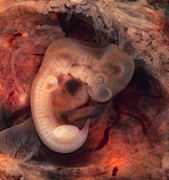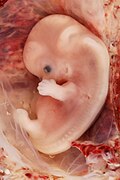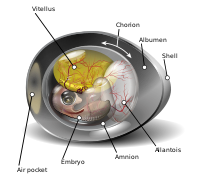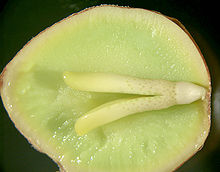Embryo
An embryo is the initial stage of development of a multicellular organism. In sexually reproducing organisms, embryonic development is the part of the life cycle that begins just after the fertilization of the female egg by the male sperm. The resulting fusion of these two cells produces a single-celled zygote that undergoes many cell divisions that produce cells known as blastomeres. The blastomeres are arranged as a solid ball that, when it reaches a certain size, called a morula, takes in fluid to create a cavity called a blastocell. The structure is then called a blastula, or blastocyst in mammals.
In the specific case of humans, the term is applied until the eighth week from conception (fertilization). After the ninth week, the embryo is called a fetus. In organisms that reproduce sexually, the fusion of the sperm and the egg in the process called fertilization determines the formation of a zygote, which contains a combination of the DNA of both parents.
After fertilization, the zygote begins a division process, which causes an increase in the number of cells, which are called blastomeres. Subsequently, a cellular differentiation process begins that will determine the formation of the different organs and tissues according to an established pattern to give rise to a final organism.
During this cell differentiation process we can distinguish three stages: blastulation, gastrulation and organogenesis. At the end of embryonic development, the resulting organism is called a fetus and will complete its development until the time of delivery.
Development
Animal Embryos
In animals, fertilization initiates the process of embryonic development with the creation of a zygote, a single cell resulting from the fusion of gametes (e.g., egg and sperm). The development of a zygote into a multicellular embryo it proceeds through a series of recognizable stages, often divided into cleavage, blastula, gastrulation, and organogenesis.
Cleavage is the period of rapid mitotic cell divisions that occur after fertilization. During cleavage, the overall size of the embryo does not change, but the size of individual cells decreases rapidly as they divide to increase the total number of cells. Cleavage gives rise to a blastula.
Depending on the species, a blastula or blastocyst stage embryo may appear as a ball of cells on the yolk, or as a hollow sphere of cells surrounding a median cavity. The cells of the embryo continue to divide and enlarge in number, while molecules within cells, such as RNAs and proteins, actively promote key developmental processes such as gene expression, cell fate specification, and polarity. Before implanting in the uterine wall, the embryo is sometimes known as a preimplantation embryo or preimplantation conceptus . It is sometimes referred to as a pre-embryo, a term used to differentiate it from an embryo proper in connection with discourses on embryonic stem cells.
Gastrulation is the next phase of embryonic development and involves the development of two or more layers of cells (germ layers). Animals that form two layers (such as Cnidarians) are called diploblastic, and those that form three (most other animals, from flatworms to humans) are called triploblastic. During gastrulation of triploblastic animals, the three germ layers that are formed are called the ectoderm, mesoderm, and endoderm. All tissues and organs of a mature animal can trace their origin to one of these layers. For example, the ectoderm will give rise to the epidermis of the skin and the nervous system, the mesoderm will give rise to the vascular system, muscles, bones, and connective tissues, and the endoderm will give rise to the organs of the digestive system. and to the epithelium of the digestive system and the respiratory system. Throughout gastrulation many visible changes occur in the embryonic structure, as the cells that make up the different germ layers migrate and cause the previously round embryo to fold or invaginate into a cup shape.
Once past gastrulation, the embryo continues to develop into a mature multicellular organism, forming the structures necessary for life outside the womb or egg. As its name indicates, organogenesis is the phase of embryonic development in which organs are formed. During organogenesis, molecular and cellular interactions drive certain populations of cells in different germ layers to differentiate into organ-specific cell types. For example, in neurogenesis, a subpopulation of ectoderm cells segregates from other cells and becomes further specializes to become the brain, spinal cord, or peripheral nerves.
The embryonic period varies from one species to another. In human development, the term fetus is used in place of embryo after the ninth week after conception, while in zebrafish, embryonic development is considered complete when a bone called the cleithrum becomes visible. In animals that hatch from an egg, such as birds, a young animal is often no longer called an embryo once it has hatched. In viviparous animals (animals whose young spend at least some time developing inside a parent's body), the young are often called an embryo while inside the parent, and are no longer considered an embryo after the birth or departure of the parent. However, the degree of development and growth that is achieved while inside an egg or parent varies significantly from one species to another, to the point that the processes that take place after hatching or birth in one species they may take place long before those events in another. Thus, according to one textbook, it is common for scientists to interpret the field of embryology broadly as the study of animal development.
Plant embryos
Flowering plants (angiosperms) create embryos after fertilization of a haploid ovule by pollen. DNA from the ovule and pollen combine to form a single-celled diploid zygote that will develop into an embryo. The zygote, which will divide multiple times as it progresses through embryonic development, is a part of a seed. Other components of the seed are the endosperm, which is a nutrient-rich tissue that will help support the embryo of the growing plant, and the seed coat, which is a protective outer covering. The first cell division of a zygote is asymmetric, resulting in an embryo with one small cell (the apical cell) and one large cell (the basal cell). The small apical cell will eventually give rise to most of the structures of the mature plant, such as the stem, leaves, and roots. The larger basal cell will give rise to the suspensor, which connects the embryo to the endosperm so that nutrients can pass between them. The cells of the plant embryo they continue to divide and progress through developmental stages named by their general appearance: globular, heart, and torpedo. In the globular stage, three basic tissue types can be recognized (dermal, terrestrial, and vascular). Dermal tissue will give rise to the epidermis or outer covering of a plant, soil tissue will give rise to the internal plant material that functions in photosynthesis, resource storage, and physical support, and the vascular tissue will give rise to connective tissues such as xylem and phloem that transport fluids, nutrients, and minerals throughout the plant. In the heart stage, they will form one or two cotyledons (embryonic leaves). The meristems (centers of stem cell activity) develop during the torpedo stage, and will eventually produce much of the mature tissue of the adult plant throughout its life. At the end of embryonic growth, the seed often becomes dormant. until germination. Once the embryo begins to germinate (grow from the seed) and forms its first true leaf, it is called a seedling.
Plants that produce spores instead of seeds, such as bryophytes and ferns, also produce embryos. In these plants, the embryo begins its existence attached to the interior of the archegonia in a parental gametophyte from which the ovule was generated. The inner wall of the archegonia is in close contact with the "foot" of the developing embryo; this "foot" it consists of a bulbous mass of cells at the base of the embryo that can receive nutrition from its parent gametophyte. The structure and development of the rest of the embryo varies depending on the group of plants.
Since all land plants create embryos, they are collectively known as embryophytes (or by their scientific name, Embryophyta). This, along with other characteristics, distinguishes land plants from other types of plants, such as algae, which do not produce embryos.
Spontaneous and induced abortion
Some embryos do not survive the development process. When this occurs for natural reasons it is called a miscarriage. There are many reasons why this can occur, but most miscarriages occur due to chromosomal abnormalities in animals. In species in which multiple embryos are produced at the same time, the spontaneous abortion of some embryos allows greater use of maternal resources for the remaining embryos. This process, however, can also damage the remaining embryos.
Induced abortion is the deliberate removal of one or more embryos through drugs or surgical procedures.
Contenido relacionado
Merostachys
Lophatherum
Gaudinia







